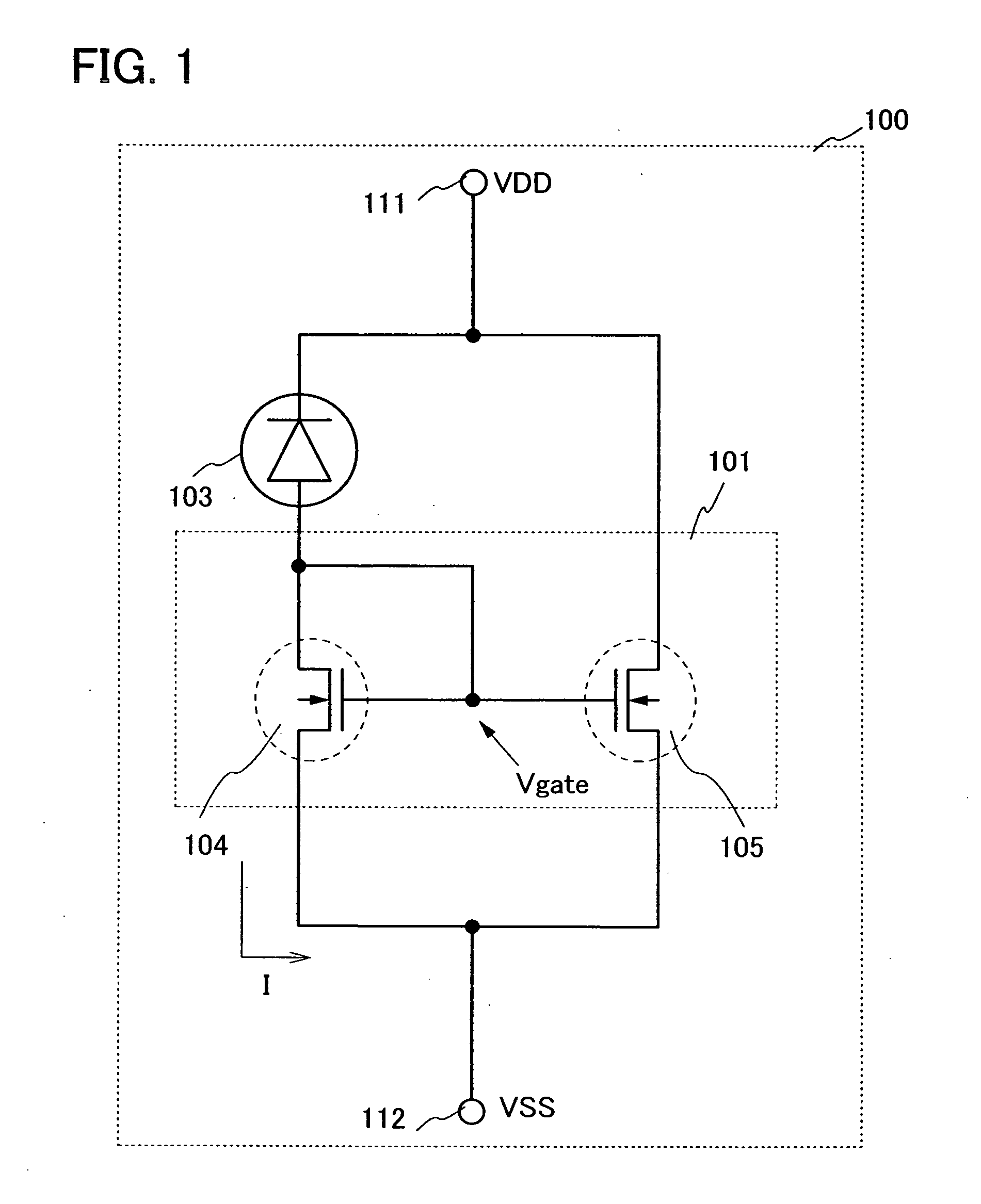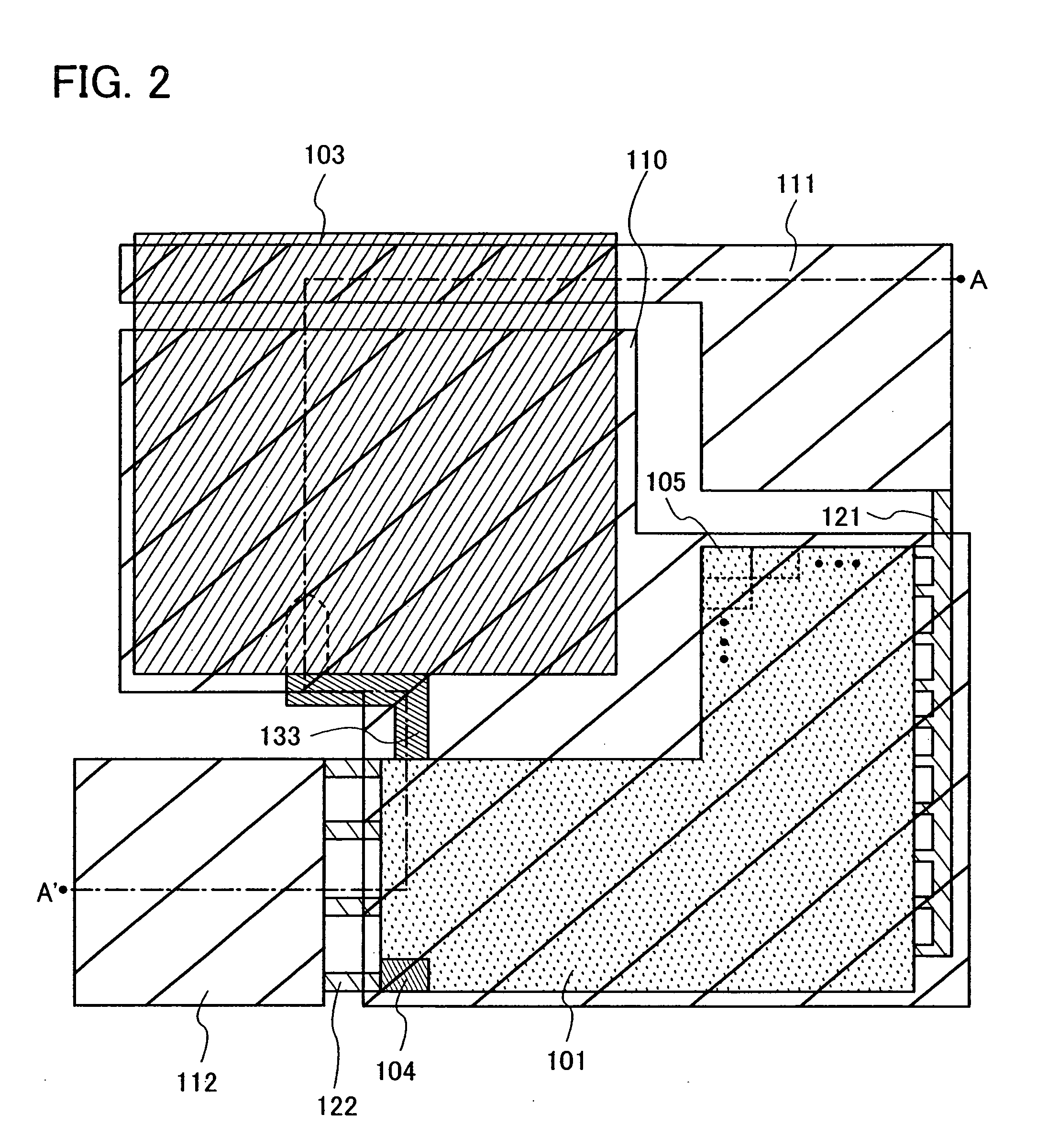Semiconductor device and electronic device
a semiconductor device and electronic device technology, applied in the field of semiconductor devices, can solve the problems of affecting the output of light sensors, the size of light sensors itself is further increased, and no countermeasures have been taken to protect against so as to improve the photovoltaic efficiency of photovoltaic elements, prevent damage due to electrostatic discharge, and increase the size of semiconductor devices
- Summary
- Abstract
- Description
- Claims
- Application Information
AI Technical Summary
Benefits of technology
Problems solved by technology
Method used
Image
Examples
embodiment mode 1
[0040]Using FIG. 1, a semiconductor device of the present invention will be described. FIG. 1 is a schematic diagram illustrating an example of a structure of a semiconductor device of the present invention. In the present embodiment mode, an example of a semiconductor device that has a photodiode used as a photovoltaic element and a current mirror circuit used as a circuit that is connected to the photovoltaic element is described.
[0041]As shown in FIG. 1, a semiconductor device 100 of the present embodiment mode has a photodiode 103 and a current mirror circuit 101 that is electrically connected to the photodiode 103. The current mirror circuit 101 is a circuit that is used to amplify the output of the photodiode 103 and is formed of a transistor 104 on the reference side and a transistor 105 on the output side. In FIG. 1, the transistor 104 and the transistor 105 are set to be n-channel transistors. Both the transistor on the output side of the current mirror circuit and the tran...
embodiment mode 2
[0094]In the present embodiment mode, another example of a structure of the semiconductor device 100 that is shown in FIG. 1 will be described. FIG. 8 is a diagram used to describe the structure of a cross section of the semiconductor device 100. FIG. 9 is a plane-view diagram used to describe an example of a layout of the semiconductor device 100.
[0095]FIG. 8, as with FIG. 3, is a cross-sectional-view diagram illustrating an example of the structure of the semiconductor device 100 when the current mirror circuit 101 is formed of top-gate n-channel TFTs. In FIG. 8, for the structure of a cross section of the current mirror circuit 101, the two transistors 104 and 105 that are provided in the current mirror circuit 101 are shown.
[0096]As shown in FIG. 8, the transistors 104 and 105 of the current mirror circuit 101 are formed over the substrate 200 with the insulating layer 201 that functions as a base film interposed between the transistors 104 and 105 and the substrate 200. In the ...
embodiment mode 3
[0114]In the present embodiment mode, another example of a structure of the semiconductor device 100 that is shown in FIG. 1 will be described. FIG. 12 is a diagram used to describe the structure of a cross section of the semiconductor device 100. FIG. 13 is a plane-view diagram used to describe an example of a layout of the semiconductor device 100 of FIG. 11.
[0115]FIG. 12, as with FIG. 3, is a cross-sectional-view diagram illustrating an example of the structure of the semiconductor device 100 when the current mirror circuit 101 is formed of top-gate n-channel TFTs. In FIG. 12, for the structure of a cross section of the current mirror circuit 101, the two transistors 104 and 105 that are provided in the current mirror circuit 101 are shown.
[0116]As shown in FIG. 12, the transistors 104 and 105 of the current mirror circuit 101 are formed over the substrate 200 with the insulating layer 201 that functions as a base film interposed between the transistors 104 and 105 and the substr...
PUM
 Login to View More
Login to View More Abstract
Description
Claims
Application Information
 Login to View More
Login to View More - R&D
- Intellectual Property
- Life Sciences
- Materials
- Tech Scout
- Unparalleled Data Quality
- Higher Quality Content
- 60% Fewer Hallucinations
Browse by: Latest US Patents, China's latest patents, Technical Efficacy Thesaurus, Application Domain, Technology Topic, Popular Technical Reports.
© 2025 PatSnap. All rights reserved.Legal|Privacy policy|Modern Slavery Act Transparency Statement|Sitemap|About US| Contact US: help@patsnap.com



